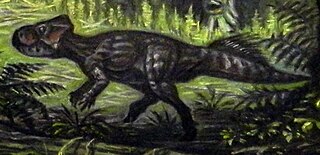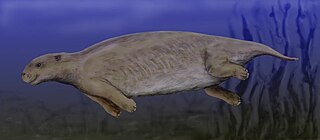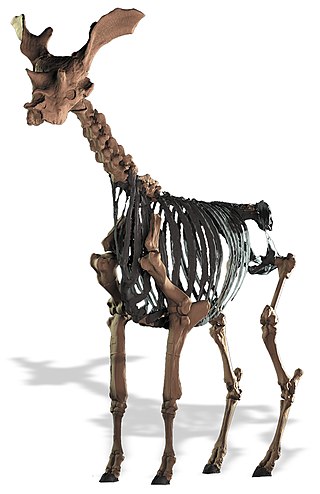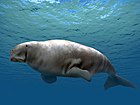
The Sirenia, commonly referred to as sea cows or sirenians, are an order of fully aquatic, herbivorous mammals that inhabit swamps, rivers, estuaries, marine wetlands, and coastal marine waters. The extant Sirenia comprise two distinct families: Dugongidae and Trichechidae with a total of four species. The Protosirenidae and Prorastomidae families are extinct. Sirenians are classified in the clade Paenungulata, alongside the elephants and the hyraxes, and evolved in the Eocene 50 million years ago (mya). The Dugongidae diverged from the Trichechidae in the late Eocene or early Oligocene.

Steller's sea cow is an extinct sirenian described by Georg Wilhelm Steller in 1741. At that time, it was found only around the Commander Islands in the Bering Sea between Alaska and Russia; its range extended across the North Pacific during the Pleistocene epoch, and likely contracted to such an extreme degree due to the glacial cycle. It is possible indigenous populations interacted with the animal before Europeans. Steller first encountered it on Vitus Bering's Great Northern Expedition when the crew became shipwrecked on Bering Island. Much of what is known about its behavior comes from Steller's observations on the island, documented in his posthumous publication On the Beasts of the Sea. Within 27 years of its discovery by Europeans, the slow-moving and easily-caught mammal was hunted into extinction for its meat, fat, and hide.

Platybelodon is an extinct genus of large herbivorous proboscidean mammals related to modern-day elephants, placed in the "shovel tusker" family Amebelodontidae. Species lived during the middle Miocene Epoch in Africa, Asia and the Caucasus.
Karl Shuker is a British zoologist, cryptozoologist and author. He lives in the Midlands, England, where he works as a zoological consultant and writer. A columnist in Fortean Times and contributor to various magazines, Shuker is also the editor-in-chief of the Journal of Cryptozoology, which began in November 2012.

Hydrodamalis is a genus of extinct herbivorous sirenian marine mammals. It included the Steller's sea cow, the Cuesta sea cow, and the Takikawa sea cow. The fossil genus Dusisiren is regarded as the sister taxon of Hydrodamalis: together, the two genera form the dugong subfamily Hydrodamalinae. They were the largest member of the order Sirenia, whose only extant members are the dugong and the manatees. They reached up to 9 metres (30 ft) in length, making the Steller's sea cow among the largest mammals other than whales to have existed in the Holocene epoch. Steller's sea cow was first described by Georg Wilhelm Steller,

Titanotylopus is an extinct genus of camel, endemic to North America from the late Hemphillian stage of the Miocene through the Irvingtonian stage of the Pleistocene. It was one of the last surviving North American camels; after its extinction, only Camelops remained.

Sea Monsters, marketed as Chased by Sea Monsters in the United States, is a 2003 three-part nature documentary television miniseries created by Impossible Pictures and produced by the BBC Studios Science Unit, the Discovery Channel and ProSieben. Following in the footsteps of The Giant Claw (2002) and Land of Giants (2003), special episodes of the nature documentary series Walking with Dinosaurs, Sea Monsters stars British wildlife presenter Nigel Marven as a "time-travelling zoologist" who travels to seven different periods of time in prehistory, diving in the "seven deadliest seas of all time" and encountering and interacting with the prehistoric creatures who inhabit them. The series is narrated by Karen Hayley in the BBC version and by Christopher Cook in the American version.

Macropoma is an extinct genus of coelacanth in the class Sarcopterygii. Fossils of Macropoma have been found in both England and Czech Republic, dating to the mid-Cretaceous (Albian-Turonian). Recorded fossils have bodies under two feet in length. A modern coelacanth measures five or more, but in other respects the two genera are remarkably similar, and share the same body plan with a three-lobed tail and stalked fins.

Microceratus is a genus of small ceratopsian dinosaur that lived in the Cretaceous period in Asia. It walked on two legs, had short front arms, a characteristic ceratopsian frill and beak-like mouth, and was around 60 cm (2.0 ft) long. It was one of the first ceratopsians, or horned dinosaurs, along with Psittacosaurus in Mongolia.

Araeoscelis is an extinct genus of tetrapods from the Early Permian of what is now Texas. Fossils have been found in the Nocona, Arroyo and Waggoner Ranch Formations. Two species have been described, A. casei and A. gracilis.

Icaronycteris is an extinct genus of microchiropteran (echolocating) bat that lived in the early Eocene, approximately 52.2 million years ago, making it the earliest bat genus known from complete skeletons, and the earliest known bat from North America. Multiple exceptionally preserved specimens, among the best preserved bat fossils, are known from the Green River Formation of North America. The best known species is I. index. Fragmentary material from France has also been tentatively placed within Icaronycteris as the second species I. menui. I. sigei is based on well-preserved fragments of dentaries and lower teeth found in Western India. In 2023, the species I. gunnelli also from the Green River Formation was distinguished from I. index, and I. menui and I. sigei were proposed to be removed from the genus due to them not being closely related.

Chapalmalania is an extinct genus of procyonid from the Late Miocene or Early Pliocene to Early Pleistocene of Argentina, Venezuela, and Colombia.

Acrophoca longirostris, also known as the swan-necked seal, is an extinct genus of Late Miocene pinniped. It was thought to have been the ancestor of the modern leopard seal; however, it is now thought to be a species of monk seal.

Prorastomus sirenoides is an extinct species of primitive sirenian that lived during the Eocene Epoch 40 million years ago in Jamaica.

Metridiochoerus is an extinct genus of swine known from the Pliocene and Pleistocene of Africa. It is also known as the giant warthog.

Sivatherium is an extinct genus of giraffid that ranged throughout Africa and Eurasia. The species Sivatherium giganteum is, by weight, one of the largest giraffids known, and also one of the largest ruminants of all time.

Sirenia is the order of placental mammals which comprises modern "sea cows" and their extinct relatives. They are the only extant herbivorous marine mammals and the only group of herbivorous mammals to have become completely aquatic. Sirenians are thought to have a 50-million-year-old fossil record. They attained modest diversity during the Oligocene and Miocene, but have since declined as a result of climatic cooling, oceanographic changes, and human interference. Two genera and four species are extant: Trichechus, which includes the three species of manatee that live along the Atlantic coasts and in rivers and coastlines of the Americas and western Africa, and Dugong, which is found in the Indian and Pacific oceans.
Steller's sea ape is a purported marine mammal, observed by German zoologist Georg Steller on August 10, 1741, around the Shumagin Islands in Alaska. The animal was described as being around 1.5 m long; with a dog-like head; long drooping whiskers; an elongated but robust body; thick fur coat; no limbs; and tail fins much like a shark. He described the creature as being playful and inquisitive like a monkey. After observing it for two hours, he attempted to shoot and collect the creature, but missed, and the creature swam away.

The Simon & Schuster Encyclopedia of Dinosaurs and Prehistoric Creatures: A Visual Who's Who of Prehistoric Life is an encyclopedia that was published in 1999 by Simon & Schuster. The book was first published in 1988.

The Cuesta sea cow is an extinct herbivorous marine mammal and is the direct ancestor of the Steller's sea cow. They reached up to 9 metres (30 ft) in length, making them among the biggest sirenians to have ever lived. They were first described in 1978 by Daryl Domning when fossils in California were unearthed. Its appearance and behavior are largely based on that of the well-documented Steller's sea cow, which, unlike the Cuesta sea cow, lived into the modern era and was well-described.


















